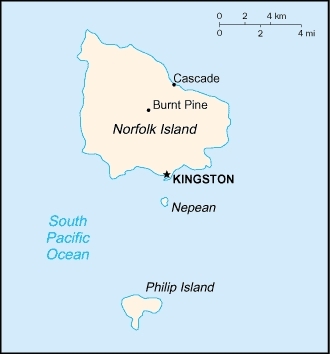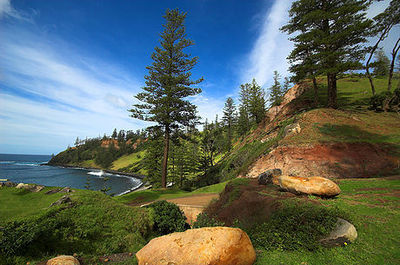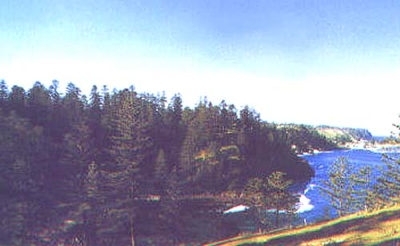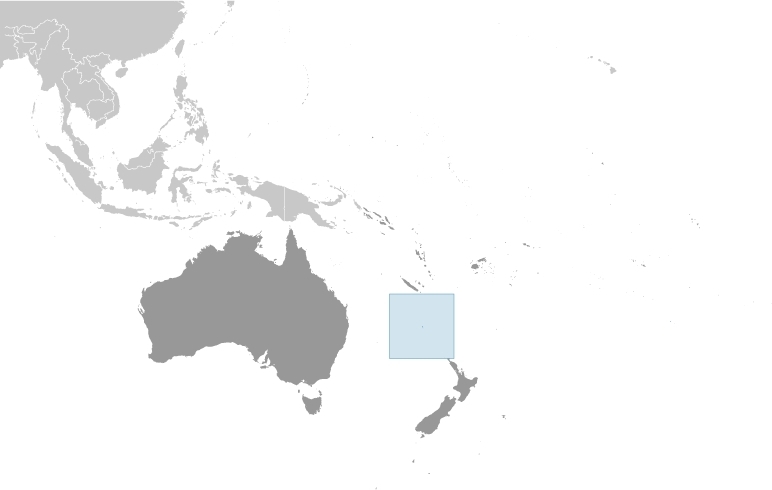Norfolk Island
| Topics: |
Countries and Regions of the World Collection  Norlfolk Island is an island group, hree small, highly isolated islands, with 2,100 people in the South Pacific Ocean, east of Australia and roughly equidistant from New Zealand and New Caledonia.
Norlfolk Island is an island group, hree small, highly isolated islands, with 2,100 people in the South Pacific Ocean, east of Australia and roughly equidistant from New Zealand and New Caledonia.
It is a self-governing territory of Australia.
 The Norfolk Island group is situated on a submarine ridge that runs between New Caledonia and the North Island of New Zealand. The Norfolk group consists of Norfolk Island, a roughly square island and two smaller, uninhabited satellite islands, Philip and Nepean Islands. These islands are the only emergent points along the Norfolk Ridge and are therefore quite isolated, approximately 1370 kilometers (km) east of Australia, 680 km south of New Caledonia, and 770 km north of New Zealand.
The Norfolk Island group is situated on a submarine ridge that runs between New Caledonia and the North Island of New Zealand. The Norfolk group consists of Norfolk Island, a roughly square island and two smaller, uninhabited satellite islands, Philip and Nepean Islands. These islands are the only emergent points along the Norfolk Ridge and are therefore quite isolated, approximately 1370 kilometers (km) east of Australia, 680 km south of New Caledonia, and 770 km north of New Zealand.
Most of the 32 km coastline consists of almost inaccessible cliffs, but the land slopes down to the sea in one small southern area on Sydney Bay, where the capital of Kingston is situated
At the time of European discovery in 1774, Norfolk Island was covered almost entirely by mixed-species subtropical rainforest, although the steep cliffs and highest slopes of Mt Pitt supported a distinct community of shrubs, herbs and climbers, dominated by the New Zealand flax (Phormium tenax).
Two British attempts at establishing the island as a penal colony (1788-1814 and 1825-55) were ultimately abandoned.
In 1856, the island was resettled by Pitcairn Islanders, descendants of the Bounty mutineers and their Tahitian companions.
Contents
Geography
Location: Oceania, island in the South Pacific Ocean, east of Australia  New Zealand flax. Source: Forest & Kim Starr/Encyclopedia of Life
New Zealand flax. Source: Forest & Kim Starr/Encyclopedia of Life
Geographic Coordinates: 29 02 S, 167 57 E
Area: 36 sq km
Coastline: 32 km
Maritime Claims:
Natural Hazards: typhoons (especially May to July)
Terrain: volcanic formation with mostly rolling plains. The highest point is Mount Bates (319 m).
Climate: subtropical; mild, little seasonal temperature variation
Ecology and Biodiversity
Norfolk island is covered by the Norfolk Island subtropical forests ecoregion.
Norfolk Island is close enough to other land masses to receive regular vagrants and colonists from across the ocean. However, the Norfolk group is isolated enough that over time, these colonists have evolved into a variety of endemic taxa. The bird and butterfly fauna, as well as the flora, are derived from three distinct sources: Australia, New Zealand, and New Caledonia.  Norfolk Island Pine. Souce: Wikimedia Commons/Encyclopedia of Life
Norfolk Island Pine. Souce: Wikimedia Commons/Encyclopedia of Life
Norfolk Island has 174 native plant species, of which 51 are endemic. Although the well-known Norfolk Island pine is still relatively common, at least 18 other endemic species are now rare or threatened. Like many of the endemic species, the Norfolk Island palm (Rhopalostylis baueri) and the smooth tree-fern (Cyathea brownii) are still common within the Norfolk Island National Park but are now rare elsewhere on the islands. The smooth tree-fern is the tallest tree-fern in the world, occasionally reaching heights of 20 m tall.
Most of the landbirds present at the time of human settlement were endemic taxa. Of the 15 species present at the time, 6 are now extinct, and a number of endemics, including three species and two subspecies, are highly endangered.
The Norfolk Island boobook (Ninox novaeseelandiae royana), an endemic owl, was reduced to a single female in 1987 but has since mated successfully with a male New Zealand boobook (Ninox novaeseelandiae), and some of their offspring have also survived and bred.
The Australian National Parks and Wildlife Service also runs a captive breeding program for the endangered Norfolk Island green parrot (Cyanoramphus novaezelandiae cookii).
There have been no confirmed sightings of the critically endangered white-chested white-eye (Zosterops albogularis) since 1980, but periodic reports indicate that a small population persists in indigenous forest.
Although locally common, both the Norfolk Island gerygone (Gerygone modesta) and the slender-billed white-eye (Zosterops tenuirostris) are considered threatened, and the slender-billed white-eye population continues to decline outside protected areas.
Two seabirds with restricted breeding ranges, the providence petrel (Pterodroma solandri) and white-necked petrel (P. cervicalis) have been reported breeding on Philip Island. The only native mammal on the islands is Gould's wattled bat (Chalinolobus gouldii) which is locally very rare or possibly extinct.
The flora and fauna of the Norfolk group has undergone massive change since human settlement of the islands, and most of the native forests have been lost. Nevertheless, the little that remains is being actively protected and managed by the Australian National Parks and Wildlife Service (ANPWS). There is a lot of restoration that can be done on the islands, and the ANPWS is leading the efforts.
The rich and extensive forests of Norfolk Island have been reduced to a single remnant patch of just 5 km2 in the Mt. Pitt area that was declared a national park in 1986. The forest within the park is fairly intact, albeit infested with several introduced plant species. A few small tracts of clifftop and coastal vegetation are protected by a series of reserves. The rest of the island, which was once almost entirely forested, has been cleared for agriculture, cattle pastures and houses. In summary, the main floral communities are all represented within the reserve and park system, but the patches that exist are extremely small.
Land clearance and introduced species have devastated the flora and fauna of the Norfolk islands. The forests have been logged and cleared for pasture and while some Norfolk Island pines and Lagunaria patersonia trees persist in the pastures, there is no regeneration due to grazing pressure. Introduced weeds have displaced native flora in some areas- by the 1960s, there were already 244 introduced plants on Norfolk Island, as compared to the 174 native species. Endemic bird species that relied on the rain forest have declined precipitously. The Norfolk Island Green Parrot was once so numerous that the convict settlers had to beat parrots off their crops with sticks, but was reduced to only 16 individuals in 1983.
Nepean Island and Philip Island were even harder hit by introduced species. Philip Island once supported a lush rain forest, but it was almost completely denuded by introduced goats, pigs and rabbits. By the mid-1980s, when these species were finally eradicated, the only remaining vegetation was a clump of hibiscus, a few Lagunaria patersonia trees, and a few weeds. Most of the topsoil had eroded away, and the freshwater streams were dry. Restoration efforts are currently underway on the island, and it is now a National Park. Nepean Island had similar problems with rabbits: almost all of the herbaceous vegetation was eaten, and all of the Norfolk Island pines have died.
People and Society
Population: 2,182 (July 2012 est.)
Ethnic Groups: descendants of the Bounty mutineers, Australian, New Zealander, Polynesian
Age Structure:
0-14 years: 20.2%15-64 years: 63.9%65 years and over: 15.9% (2009 est.)
Population Growth Rate: 0.006% (2011 est.)
Languages: English (official), Norfolk (a mixture of 18th century English and ancient Tahitian)
Government
Dependency status: self-governing territory of Australia; administered from Canberra by the Department of Regional Australia, Regional Development and Local Government
Capital: Kingston
Legal System: English common law and the laws of Australia
Resources
Natural Resources: fish
Land Use:
arable land: 0%
permanent crops: 0%
other: 100% (2005)
Economy
Tourism, the primary economic activity, has steadily increased over the years and has brought a level of prosperity unusual among inhabitants of the Pacific islands. The agricultural sector has become self sufficient in the production of beef, poultry, and eggs.
Agricultural products: Norfolk Island pine seed, Kentia palm seed, cereals, vegetables, fruit; cattle, poultry
Industries: tourism, light industry, ready mixed concrete
Currency: Australian dollars (AUD)

